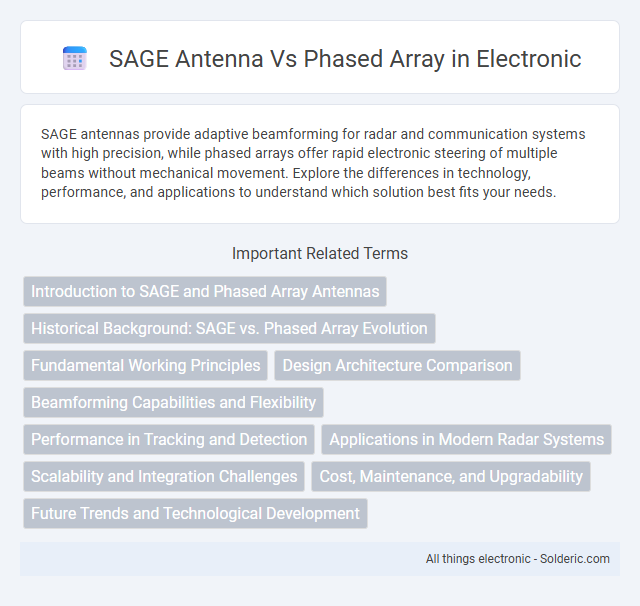SAGE antennas provide adaptive beamforming for radar and communication systems with high precision, while phased arrays offer rapid electronic steering of multiple beams without mechanical movement. Explore the differences in technology, performance, and applications to understand which solution best fits your needs.
Comparison Table
| Feature | SAGE Antenna | Phased Array |
|---|---|---|
| Technology | Adaptive antenna system using Smart Antenna Grid Elements (SAGE) | Array of antennas with electronically controlled phase shifting |
| Beamforming | Dynamic beamforming with adaptive algorithms | Electronic beam steering via phase control |
| Application | Mobile communications, signal enhancement, interference suppression | Radar, satellite communication, 5G wireless networks |
| Complexity | Moderate complexity with adaptive signal processing | High complexity due to phase shifters and control circuitry |
| Cost | Lower to moderate, depending on system size | Higher, due to advanced hardware requirements |
| Scalability | Scalable with flexible array size | Highly scalable with modular antenna elements |
| Latency | Low to moderate latency in adaptive response | Very low latency for beam steering |
| Frequency Range | Typically operates in cellular frequency bands | Wide frequency range including microwave and millimeter waves |
Introduction to SAGE and Phased Array Antennas
SAGE (Smart Adaptive Ground Environment) antennas utilize advanced signal processing to dynamically adjust radiation patterns for optimized target detection and tracking, enhancing radar system performance. Phased array antennas consist of multiple radiating elements with variable phase shifts, enabling electronic beam steering without mechanical movement, which improves response time and directional accuracy. Both technologies are pivotal in modern radar and communication systems, with SAGE focusing on adaptive signal management and phased arrays emphasizing flexible, rapid beam control.
Historical Background: SAGE vs. Phased Array Evolution
The Semi-Automatic Ground Environment (SAGE) system, developed in the 1950s, marked a pioneering era in radar technology by using large, mechanically steered antennas linked to early computers for real-time air defense. Phased array antennas emerged later, revolutionizing radar capability with electronically controlled beams that enable faster, more precise target tracking without moving parts. Your understanding of radar evolution highlights how phased array technology built upon and vastly improved the foundation laid by the SAGE system.
Fundamental Working Principles
SAGE antennas use a single-element structure with mechanical steering to direct signals, employing physical movement to adjust the antenna's orientation and achieve beam direction. Phased array antennas leverage multiple fixed elements with controlled phase shifts across the array, enabling electronic beamforming and rapid direction changes without moving parts. This fundamental difference results in SAGE antennas being simpler but slower in beam steering, while phased arrays offer agility and precision through electronic control of signal phases.
Design Architecture Comparison
SAGE antennas employ a simplified, modular design with electronically steerable beams using fixed antenna elements, optimizing cost and ease of deployment. Phased array antennas feature complex, tightly packed elements with precise phase control, enabling rapid beam steering and higher resolution. Your choice between SAGE and phased array depends on requirements for scalability, precision, and system complexity in the intended application.
Beamforming Capabilities and Flexibility
SAGE antennas offer dynamic beamforming capabilities with rapid electronic steering, enabling precise target tracking and adaptive coverage without mechanical movement. Phased array systems excel in generating multiple simultaneous beams, providing high flexibility for multi-target engagement and complex signal environments. Your communication system benefits from selecting a SAGE antenna for real-time beam agility or a phased array for extensive multitasking and spatial diversity.
Performance in Tracking and Detection
SAGE antennas deliver highly accurate tracking and detection through advanced beamforming techniques that optimize signal clarity and reduce interference. Phased array systems excel in dynamic target tracking with rapid beam steering capabilities, enabling real-time adaptability in complex environments. Your choice depends on whether precision in static scenarios or agile tracking in changing conditions is the priority.
Applications in Modern Radar Systems
SAGE antennas excel in electronic warfare and surveillance radar due to their wideband capabilities and fast beam steering, enhancing target detection accuracy in dynamic environments. Phased array antennas dominate advanced radar systems like missile tracking and air traffic control by providing rapid beam steering, high resolution, and multi-target tracking through electronic phase control of individual elements. Both technologies are integral in modern radar architectures, with SAGE antennas favored for adaptability and phased arrays prized for precision and scalability.
Scalability and Integration Challenges
SAGE antennas offer easier scalability due to their modular design, allowing incremental expansion without significant system redesign, while phased arrays require complex integration as the number of elements increases, impacting system size and cost. The integration challenges with phased arrays often involve precise calibration and sophisticated beamforming algorithms to maintain performance, whereas SAGE systems benefit from simplified integration but may face limitations in achieving high-resolution beam steering. Scalability in phased arrays is hindered by the need for advanced RF components and thermal management, whereas SAGE technology supports more flexible deployment in varying operational environments.
Cost, Maintenance, and Upgradability
SAGE antennas typically offer lower initial costs and simpler maintenance compared to phased array systems, which require complex electronics and software updates. Phased array antennas provide superior upgradability with modular components and firmware enhancements, enabling advanced features without extensive hardware changes. Your decision depends on balancing budget constraints against the need for adaptable, high-performance antenna technology.
Future Trends and Technological Development
SAGE antennas and phased array systems are evolving rapidly with advancements in materials such as metamaterials and AI-driven beamforming techniques enhancing performance and adaptability. Future trends emphasize increased real-time signal processing capabilities and miniaturization, enabling more efficient and flexible deployment in 5G networks, satellite communications, and defense applications. Your choice between SAGE and phased array will hinge on specific requirements for scalability, cost, and dynamic beam steering in next-generation wireless technologies.
SAGE antenna vs phased array Infographic

 solderic.com
solderic.com